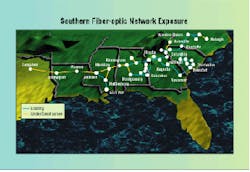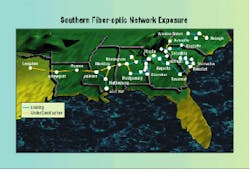Fiber-optic networks thread the deep South
Fiber-optic networks thread the deep South
MARY GREEN BROWN SCANA CORP.
TIM JONES AND STEVE BLACKWELL MPX SYSTEMS
MPX Systems, the telecommunications subsidiary of the Columbia, SC-based energy holding company, Scana Corp., began installation of more than 900 miles of fiber-optic cable in July 1994. Through a joint venture with Interstate Fibernet of West Point, GA, MPX is expanding its fiber-optic networks from the Carolinas through Georgia, Alabama, Mississippi and Louisiana to Texas.
The 900-route-mile project includes expansion into new systems, as well as the construction of additional fiber-optic lines and equipment to improve reliability in existing systems. In the design of the project, several diverse networks have been installed. A major objective is to enhance system reliability in the Atlanta to Birmingham cross section.
Plans call for the conversion of the existing linear asynchronous route to a synchronous optical network optical carrier, level 48 (2.5-gigabit-per-second) bidirectional line-switched ring architecture using electronic equipment from Northern Telecom Inc. In this configuration, traffic via the OC-48 bandwidth is normally distributed on both sides of the ring. If an electronics malfunction, cable break or other deficiency occurs on either side, the system automatically switches to the working side, thereby providing a higher order of system reliability compared with a single-line or "single-thread" design.
The expansion also includes another installation of a 2.5-Gbit/sec OC-48 system from Meridian, MS, to Gulfport, MS. This system is expected to be in place by the end of this month. A major application for the project calls for providing a major carrier with a number of dark fibers in the new cables from Atlanta to Shreveport, LA. The combined applications supported the financial viability of the 900-mile build, because each by itself was insufficient to warrant construction.
As the needs of the industry increase and competition among telecommunications carriers becomes intense, a corresponding increase in the demand for improved reliability in fiber-optic networks has occurred. To meet this demand, MPX continues to expand its fiber-optic systems with ring architectures and diverse fiber-optic cable routes.
Network reliability is also enhanced by the monitoring of critical performance indicators and alarms available at Interstate Fibernet`s network control center in West Point. The network control center, which operates 24 hours a day, seven days a week, employs a mechanized network management system.
Rights-of-way
Using existing power-line rights-of-way provides a cost-effective means of installing fiber-optic cable. Fortunately, utility companies are anxious to gain access to the information superhighway via fiber optics. They are therefore forming partnerships with MPX Systems and typically obtain rights to a certain number of the fiber strands contained in the cables installed above their transmission and distribution lines. In large part, utility crews are installing and maintaining the fiber. MPX is participating with Southern Co. and Entergy, for example, in constructing the Atlanta to Shreveport line.
The fiber cable types selected for this project include optical ground wire cable and dielectric sheath fiber cable. The optical ground wire cable consists of a fiber-optic strand in the core with the exterior wrapped by metallic conductors; this assembly enables cable usage for both electrical static line and fiber-optic communications purposes. The optical ground wire is placed on electrical transmission lines of power companies. MPX primarily uses optical ground wire cables containing 24, 36 and 48 strands. On selected routes, optional cable selection includes all-dielectric self-support fiber cable, which is presently available in sizes to 144 fibers, compared with the optical ground wire cable current maximum of 68 fibers.
Fiber-optic support electronics along the fiber route is typically co-located at electrical substations, an advantage in terms of cost and security. Furthermore, electrical power is usually maintained to substations even during outages. Fiber cables installed along overhead transmission lines are more secure from physical damage than buried lines because contractors cannot dig into the line, and intruders or saboteurs are unlikely to interfere with a fiber line located beside a high-voltage electrical line. A 48-strand optical ground wire cable is being used for the Atlanta to Meridian portion of this 900-mile project.
Although a majority of the fiber expansion project is being constructed along overhead transmission lines, a portion of the system is being buried along railroad rights-of-way. These buried right-of-way sections are proving more economical because they result in a more direct route than could be obtained on the transmission lines. When cable is buried, the relatively new method of directional boring is used at critical locations, including underwater, at railroad crossings and at major traffic intersections. Other sections were buried using conventional trenching and plowing construction techniques. A 48-strand dielectric sheath fiber cable is being buried for the terrain portions of the project, primarily between Meridian and Shreveport.
To meet customer demands, portions of the line were constructed simultaneously throughout the system. Utility crews constructed the sections on utility rights-of-way while contractors installed the buried lines. A majority of the fiber-optic cable was installed by the end of 1994. Splicing and installation of electronic equipment will continue through the end of this month, when the OC-48 ring architecture system is expected to be operational. q
Mary Green Brown is public affairs coordinator at Scana Corp., Columbia, SC. Tim Jones is systems marketing manager and Steve Blackwell is operations manager at MPX Systems, the telecommunications subsidiary of Scana Corp.Encompassing 2500 miles, fiber-optic networks are spreading throughout seven southern states via aerial lines and along railroad rights-of-way.

